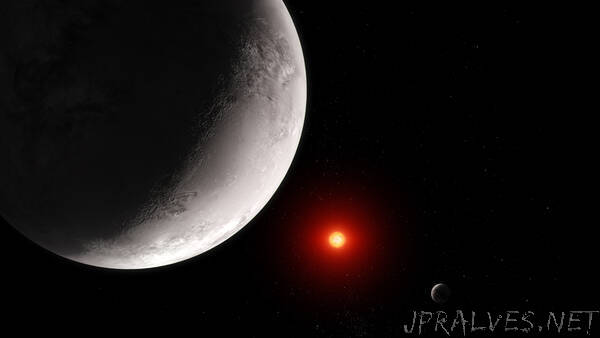
“Researchers observed TRAPPIST-1 c on four occasions using the telescope’s Mid-Infrared Instrument.
An international team of researchers has used NASA’s James Webb Space Telescope to calculate the amount of heat energy coming from the rocky exoplanet TRAPPIST-1 c.
The result suggests that the planet’s atmosphere – if it exists at all – is extremely thin.
With a dayside temperature of roughly 380 kelvins (about 225 degrees Fahrenheit), TRAPPIST-1 c is now the coolest rocky exoplanet ever characterized based on thermal emission. The precision necessary for these measurements further demonstrates Webb’s utility in characterizing rocky exoplanets similar in size and temperature to those in our own solar system.
The result marks another step in determining whether planets orbiting small red dwarfs like TRAPPIST-1 – the most common type of star in the galaxy – can sustain atmospheres needed to support life as we know it.
“We want to know if rocky planets have atmospheres or not,” said Sebastian Zieba, a graduate student at the Max Planck Institute for Astronomy in Germany and first author on results published June 19, in Nature. “In the past, we could only really study planets with thick, hydrogen-rich atmospheres. With Webb we can finally start to search for atmospheres dominated by oxygen, nitrogen, and carbon dioxide.”
“TRAPPIST-1 c is interesting because it’s basically a Venus twin: It’s about the same size as Venus and receives a similar amount of radiation from its host star as Venus gets from the Sun,” explained co-author Laura Kreidberg, also from Max Planck. “We thought it could have a thick carbon dioxide atmosphere like Venus.”
TRAPPIST-1 c is one of seven rocky planets orbiting an ultracool red dwarf star (or M dwarf) 40 light-years from Earth. Although the planets are similar in size and mass to the inner, rocky planets in our own solar system, it is not clear whether they do in fact have similar atmospheres. During the first billion years of their lives, M dwarfs emit bright X-ray and ultraviolet radiation that can easily strip away a young planetary atmosphere. In addition, there may or may not have been enough water, carbon dioxide, and other volatiles available to make substantial atmospheres when the planets formed.
To address these questions, the team used MIRI (Webb’s Mid-Infrared Instrument) to observe the TRAPPIST-1 system on four separate occasions as the planet moved behind the star, a phenomenon known as a secondary eclipse. By comparing the brightness when the planet is behind the star (starlight only) to the brightness when the planet is beside the star (light from the star and planet combined) the team was able to calculate the amount of mid-infrared light with wavelengths of 15 microns given off by the dayside of the planet.
This method is the same as that used by another research team to determine that TRAPPIST-1 b, the innermost planet in the system, is probably devoid of any atmosphere.
The amount of mid-infrared light emitted by a planet is directly related to its temperature, which is in turn influenced by atmosphere. Carbon dioxide gas preferentially absorbs 15-micron light, making the planet appear dimmer at that wavelength. However, clouds can reflect light, making the planet appear brighter and masking the presence of carbon dioxide.
In addition, a substantial atmosphere of any composition will redistribute heat from the dayside to the nightside, causing the dayside temperature to be lower than it would be without an atmosphere. (Because TRAPPIST-1 c orbits so close to its star – about 1/50th the distance between Venus and the Sun – it is thought to be tidally locked, with one side in perpetual daylight and the other in endless darkness.)
Although these initial measurements do not provide definitive information about the nature of TRAPPIST-1 c, they do help narrow down the likely possibilities. “Our results are consistent with the planet being a bare rock with no atmosphere, or the planet having a really thin CO2 atmosphere (thinner than on Earth or even Mars) with no clouds,” said Zieba. “If the planet had a thick CO2 atmosphere, we would have observed a really shallow secondary eclipse, or none at all. This is because the CO2 would be absorbing all of the 15-micron light, so we wouldn’t detect any coming from the planet.”
The data also shows that it is unlikely the planet is a true Venus analog with a thick CO2 atmosphere and sulfuric acid clouds.
The absence of a thick atmosphere suggests that the planet may have formed with relatively little water. If the cooler, more temperate TRAPPIST-1 planets formed under similar conditions, they too may have started with little of the water and other components necessary to make a planet habitable.
The sensitivity required to distinguish between various atmospheric scenarios on such a small planet so far away is truly remarkable. The decrease in brightness that Webb detected during the secondary eclipse was just 0.04%, equivalent to looking at a display of 10,000 tiny light bulbs and noticing that just four have gone out.
“It is extraordinary that we can measure this,” said Kreidberg. “There have been questions for decades now about whether rocky planets can keep atmospheres. Webb’s ability really brings us into a regime where we can start to compare exoplanet systems to our solar system in a way that we never have before.”
This research was conducted as part of Webb’s General Observers (GO) program 2304, which is one of eight programs from Webb’s first year of science designed to help fully characterize the TRAPPIST-1 system. This coming year, researchers will conduct a follow-up investigation to observe the full orbits of TRAPPIST-1 b and TRAPPIST-1 c. This will make it possible to see how the temperatures change from the day to the nightsides of the two planets and will provide further constraints on whether they have atmospheres or not.”
